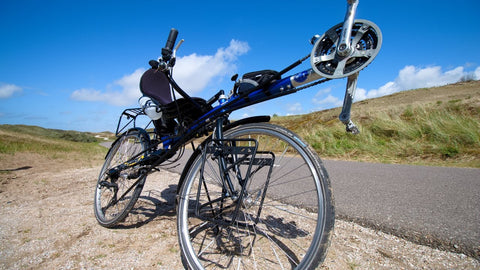Introduction
A recumbent bike is a unique type of stationary exercise equipment that offers a comfortable and effective workout experience. With its reclined seating position and ergonomic design, it has become an increasingly popular choice for fitness enthusiasts of all ages and abilities. In this article, we'll explore the benefits of recumbent bikes, what they are good for, and how they compare to other exercise bikes. We'll also take a look at some great cycling gear to enhance your workouts, including our top picks for cycling kit collections and cycling jersey collections.
Brief overview of recumbent bikes
Recumbent bikes are designed with a low, reclined seat that supports the back and distributes the user's weight more evenly. This setup allows for a more relaxed and comfortable workout experience compared to traditional upright exercise bikes.
Importance of recumbent bikes in fitness routines
Incorporating a recumbent bike into your fitness routine can provide several health benefits, including cardiovascular fitness, muscle engagement, and core strengthening. Additionally, the low-impact nature of the exercise can make it an ideal choice for those with joint issues or recovering from injuries.
Mention of key sections to be covered in the article
In the sections to follow, we'll delve into the various advantages of recumbent bikes, discuss their limitations, and provide tips on how to use them effectively for weight loss and muscle toning. But before we dive in, don't forget to check out our recommendations for the perfect cycling kit collection and cycling jersey collection to complement your recumbent bike workouts.

What is a Recumbent Bike Good For?
Low-impact exercise option
One of the main benefits of using a recumbent bike is the low-impact nature of the exercise. The seated position and reclined back support reduce stress on the joints, making it an excellent option for individuals with arthritis or other joint-related issues.Comfort and ergonomic advantages
Recumbent bikes are designed with user comfort in mind. The reclined seat provides ample support for the back and buttocks, while the ergonomic design encourages proper posture and reduces the risk of discomfort or injury during workouts.
Suitable for people with physical limitations
Due to their low-impact and comfortable design, recumbent bikes are an ideal choice for individuals with physical limitations or mobility issues. They allow users to engage in cardiovascular exercise without putting undue stress on the body.
Cardiovascular benefits
Regular use of a recumbent bike can improve cardiovascular health by increasing heart rate and promoting blood circulation. This can lead to a reduced risk of heart disease, lower blood pressure, and improved overall fitness.
Improved core strength and muscle engagement
While cycling on a recumbent bike, users engage a variety of muscle groups, including the glutes, quads, hamstrings, and calves. Additionally, the reclined position promotes increased core strength and stability during workouts.

Disadvantages of Recumbent Bikes
Limited muscle groups targeted
Although recumbent bikes provide an effective workout for the lower body and core muscles, they may not engage the upper body as effectively as other forms of exercise, such as upright cycling or rowing.
Less effective for weight loss compared to other exercise options
While recumbent bikes can help burn calories and contribute to weight loss, they may not be as effective as other higher-intensity workouts, like running or spinning. However, when combined with a healthy diet and strength training, recumbent bike workouts can still be a valuable part of a weight loss plan.
Space requirements and cost
Recumbent bikes tend to be larger than upright exercise bikes, which may be a concern for those with limited space. Additionally, high-quality recumbent bikes can be more expensive than other types of exercise equipment.
Learning curve for proper use
It may take some time for users to get accustomed to the unique seating position and pedal mechanics of a recumbent bike. Proper form is essential for maximizing workout effectiveness and minimizing the risk of injury.
Is a Recumbent Bike as Good as a Regular Exercise Bike?
Comparing workout experiences
Recumbent bikes and regular exercise bikes offer distinct workout experiences. Recumbent bikes provide a more comfortable, low-impact workout due to their reclined seating position and back support. In contrast, regular exercise bikes, also known as upright bikes, mimic the feel of outdoor cycling and may offer a more intense workout.
Muscle engagement and workout intensity
Both recumbent and upright bikes engage the lower body muscles, including the quadriceps, hamstrings, glutes, and calves. However, upright bikes may engage more upper body muscles, such as the core and arms, due to their upright posture. The workout intensity on both types of bikes can be adjusted using resistance levels and varying speed.
Choosing the right bike for your fitness goals
Your choice between a recumbent and regular exercise bike should depend on your specific fitness goals and personal preferences. If you prioritize comfort and low-impact workouts, a recumbent bike may be the better choice. On the other hand, if you're looking for a more challenging and traditional cycling experience, an upright bike might be more suitable.
Considerations for individuals with physical limitations
Recumbent bikes can be an excellent choice for those with physical limitations, joint issues, or mobility concerns, as they provide a comfortable and supportive workout experience. Upright bikes, while offering a more traditional workout, may not be as suitable for individuals with back problems or other physical challenges.
Assessing personal preferences and comfort
Ultimately, the best exercise bike for you depends on your personal preferences and comfort levels. It's essential to try both recumbent and regular exercise bikes to determine which one aligns with your workout goals, physical capabilities, and overall enjoyment.

What Muscles Does a Recumbent Bike Work Out?
Primary muscle groups targeted
Recumbent bikes primarily target the lower body, including the quadriceps, hamstrings, glutes, and calves. These muscles are responsible for the majority of the pedaling action and provide power and stability during the workout.
Secondary muscle groups engaged
In addition to the lower body muscles, recumbent bikes also engage secondary muscle groups such as the core, hip flexors, and lower back muscles. The reclined position of the bike encourages better posture and core engagement, contributing to overall stability and balance.
Tips for maximizing muscle engagement during workouts
To get the most out of your recumbent bike workout, focus on maintaining proper form and posture. Keep your back pressed against the seat, engage your core, and pedal with a smooth and controlled motion. Adjust the resistance and speed to challenge your muscles and increase workout intensity.
How Long Should I Exercise on a Recumbent Bike?
Recommended workout duration for beginners
For beginners, start with shorter sessions of 15-20 minutes on the recumbent bike at a moderate intensity. As you become more comfortable and build endurance, gradually increase the duration of your workouts.
Progressing workout duration and intensity over time
As your fitness level improves, aim for 30-45 minute sessions on the recumbent bike, with a combination of low, moderate, and high-intensity intervals. This approach will help prevent plateaus and ensure that you continue to challenge your cardiovascular system and muscles.
Factors affecting the ideal workout length
The ideal workout length on a recumbent bike depends on various factors, such as your fitness goals, available time, and current fitness level. Always listen to your body and adjust your workouts accordingly to avoid overtraining or injury.
Importance of listening to your body
Pay close attention to your body's signals during workouts. If you experience pain, discomfort, or excessive fatigue, it's crucial to modify your workout duration or intensity as needed. Remember that consistency and gradual progression are key to achieving long-term fitness goals.

Conclusion
In summary, recumbent bikes offer a comfortable and low-impact exercise option with numerous benefits, including improved cardiovascular health, muscle engagement, and core strength. While they may have some limitations, such as targeting fewer muscle groups and being less effective for weight loss compared to other forms of exercise, they can still be a valuable part of a balanced fitness routine.
When choosing between a recumbent and regular exercise bike, consider your fitness goals, personal preferences, and any physical limitations. Don't forget to check out our recommended cycling kit collection and cycling jersey collection to complete your workout experience. By incorporating recumbent bike workouts into your exercise routine and following the tips provided in this article, you can enjoy the many advantages of this unique form of exercise.











